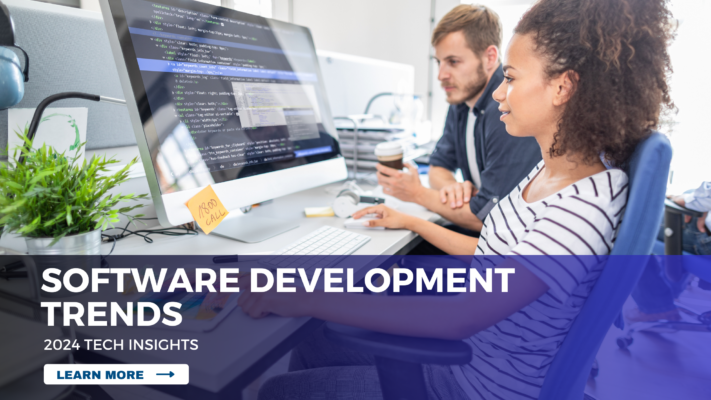
- April 8 2024
- admin
The software development landscape continues to evolve at breakneck speed. As developers, staying updated on emerging technologies and best practices is key to delivering impactful solutions. In this blog, we will journey through some of the top software development trends that are shaping practices in 2024.
The Rise of Low-Code/No-Code
Low-code/no-code platforms allow faster application development with minimal hand-coding. According to Gartner, low-code application development will account for 65% of all app dev activity by 2024. With intuitive visual interfaces and prebuilt components, platforms like Appian, Mendix, and OutSystems enable rapid delivery even by non-developers. Low code is disrupting software development by expanding the talent pool and reducing project timelines.
Containers Continue to Gain Traction
Container technologies like Docker simplify dependency management and environment configuration for apps. Containers package software with everything needed to run it uniformly across environments. Their lightweight nature provides flexibility and portability across cloud infrastructures. According to RedHat, 50% of enterprise apps will run in containers by 2022. As microservices and DevOps practices mature, container adoption will grow for streamlining software development workflows.
The API-First Paradigm
APIs are the driving force behind digital experiences. Adopting an API-first approach where APIs are developed first is crucial for agile ecosystems. API-first promotes reuse, consistency, and interoperability. It decouples frontend and backend software development while enabling third-party integration. Standards like OpenAPI Specification and tools like Postman streamline API-first practices. They will become integral to modern software development in 2024.
AI Assisted Development
AI is playing an increasing role in augmenting human development. Autocomplete, error checking, and debugging tools integrated into IDEs utilize AI to increase productivity. Automated code reviews using AI identify quality issues and suggest improvements. AI test generation tools like Functionize Auto can generate test data for scenarios difficult to manually cover. As AI/ML models become more accurate, their assistance will enable developers to focus on complex coding.
The March to 5G is Accelerating
5G networks promise faster speeds, lower latency, and more reliable connections. These benefits can significantly impact software, especially real-time apps for IoT, AR/VR, and autonomous systems. In 2024, 5G coverage will see further expansion globally. Software development will be influenced by opportunities around edge computing, network slicing, and multi-access capabilities. Architecting systems ready for 5G will provide a distinct competitive advantage.
WebAssembly Penetration Increases
WebAssembly is a bytecode format that runs with near-native performance in web browsers. It enables C/C++, Rust, and other languages to be compiled for the web. The adoption of WebAssembly unlocks performance-sensitive use cases like 3D rendering, gaming, machine learning, etc. As per Statista, over 50% of developers already use WebAssembly. Its cross-platform delivery, security, and speed make it an emerging standard for web software development.
The Rise of Platform Engineering
To manage cloud complexity, organizations are adopting platform engineering teams. They streamline cloud operations and provision fully managed stacks for developers. This shift from infrastructure management enables developers to focus on business logic. It also improves productivity and consistency. As cloud-native software development grows, dedicated platform engineering teams will become crucial.
Everything Evolves Toward As-a-Service
Consumption-based models are permeating software buying habits. Rather than big upfront investments, businesses prefer pay-per-use models for flexibility and cost control. This applies equally to infrastructure, platforms, monitoring tools, and more. Serverless computing is a prime example of the as-a-service model. As cloud maturity increases, businesses will become smarter consumers through managed services over DIY options.
Shift Left Continues to Gain Prominence
Shift left emphasizes moving quality upstream and testing early in the SDLC. With practices like test-driven software development (TDD), defects are caught early before making downstream. Automated testing and observability in pre-production reduce escape defects. Shift left improves software quality and developer productivity. According to Gartner, 60% of organizations practice shift left up from 20% in 2020. The culture change will grow as organizations realize the associated benefits.
Importance of DesignOps Strengthens
DesignOps enables greater collaboration between design and development teams in the SDLC. It implements cross-functional workflows so design and UX improvements map to feature software development. As customers expect refined digital experiences, integrating design deeper via DesignOps and tooling helps. Design sprints, design systems, and customer journey mapping are some DesignOps techniques that will grow more mainstream in 2024.
Security is Baked In
With increasing cyber threats, secure software development practices are a must. Techniques like threat modeling, automated scanners, penetration testing, and OWASP Top 10 adherence allow proactive security. DevSecOps integrates security scans in pipelines to Shift security left. Languages introducing security features like Rust prevent common vulnerabilities. As software powers critical systems, threat awareness and prevention capability for developers will be highly valued.
The Great Resignation Spurs Talent Innovation
The Great Resignation has exacerbated the developer talent crunch. Organizations must get creative in sourcing skills and retaining teams. Strategies like hackathons, upskilling programs, remote work, and diversity initiatives help talent attraction. Improved knowledge management and documentation minimize the impact of attrition. Dev teams blending internal talent, remote workers, and managed services will better weather the talent churn storm.
Low-Code Corroborates No-Code
Low-code platforms empower professional developers with abstractions for quick software development. No code enables business users and citizen developers to build apps visually. Low-code and no-code platforms complement each other in closing software development gaps. Integrations between them assist complex enterprise needs that may not be fully addressed by a standalone platform. Blending low-code and no-code with custom code will be the balanced approach.
Everything Continues Evolving to the Edge
Edge computing is a distributed model bringing computation and data storage closer to devices and users. It addresses limitations around bandwidth, latency, and security for emerging technologies like IoT, AR/VR, etc. By 2025, Gartner predicts 75% of enterprise data will be processed outside the cloud. Edges ranging from on-premise servers to smart devices will transform networks into intelligent mesh. Developers must start building edge-aware systems to fully leverage this distributed opportunity.
Wrap Up
From low-code, cloud-native software development to 5G and edge computing, profound shifts are underway in how software is built, deployed, and consumed. Developers must embrace a culture of continuous learning to stay relevant. Organizations that strategically combine internal teams, remote talent, and managed tech partners will have an advantage in turning these software development trends into tangible outcomes.
At Upcore Technologies, we are hands-on practitioners of leading-edge technologies. Our global talent pool and dedicated pods collaborate end-to-end from shaping solutions to execution and ongoing support. Get in touch to see how we can help chart your software innovation journey leveraging the latest software development trends.


